The AMD Radeon RX 480 Preview: Polaris Makes Its Mainstream Mark
by Ryan Smith on June 29, 2016 9:00 AM ESTPower, Temperature, & Noise
Given AMD’s focus on power efficiency with Polaris – not to mention the overall benefits of the move to 14nm FinFET – there is a lot of interest in just how the RX 480 stacks up when it comes to power, temperature, and noise. So without further ado…

When it comes to idle power consumption I'm posting the results I've measured as-is, but I want to note that I have low confidence in these results for the AMD cards. Ever since the GPU testbed was updated from Windows 8.1 to Windows 10, AMD cards have idled 3-5W higher than they used to under Windows 8.1. I believe that this is an AMD driver bug – NVIDIA’s cards clearly have no problem – possibly related to the GPU tested being an Ivy Bridge-E system. In this case I don’t believe RX 480’s idle power consumption is any higher than GTX 960’s, but for the moment the testbed is unable to prove it.
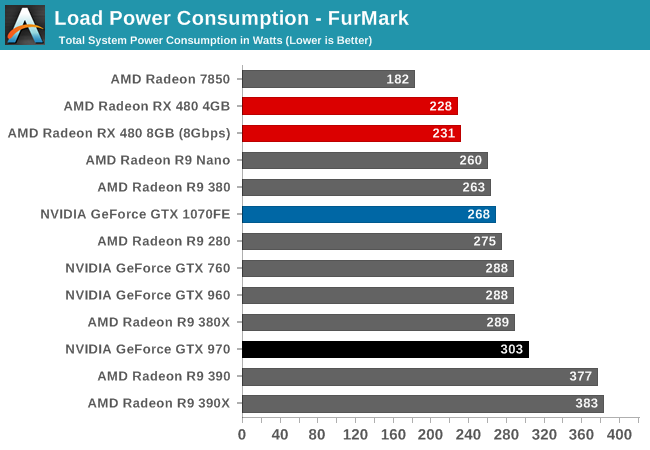
Traditionally we start with gaming load power before moving on to FurMark, but in this instance I want to flip that. As a power virus type workload, FurMark’s power requirements are greater than any game. But because it’s synthetic, it gives us a cleaner look at just GPU power consumption.
Among AMD’s cards, the RX 480 is second to only the Radeon HD 7850 in power consumption. Even then, as a GCN 1.0 card, the 7850 is one of the last AMD cards without fine-grained power states, so this isn’t a true apples-to-apples comparison. Instead a better point of reference is the GCN 1.2 based R9 Nano, which has a 175W TBP. Compared to the R9 Nano we find that the RX 480 draws about 30W less at the wall, which almost perfectly translates to the 25W difference in TBP. As a result we can see first-hand the progress AMD has made on containing power consumption with Polaris.
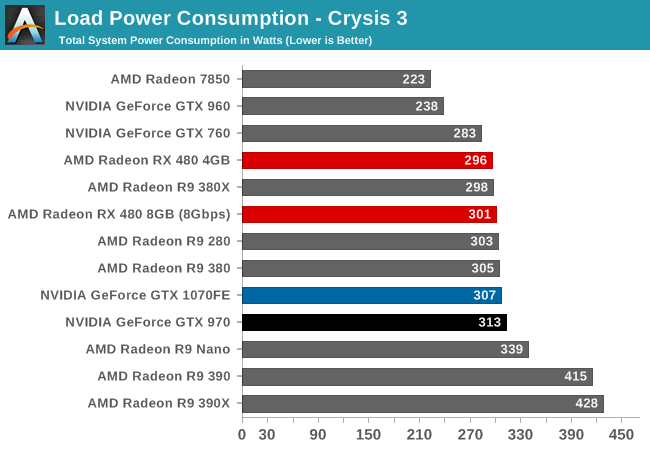
However things are a bit more mixed under Crysis 3. RX 480 is still near the top of our charts, and keeping in mind that higher performing cards draw more power on this test due to the additional CPU workload, the RX 480 compares very favorably to the rest of AMD’s lineup. System power consumption is very close to R9 280/380 for much improved performance, and against the performance-comparable R9 390, we’re looking at over 110W in savings. Hawaii was a solid chip from a performance standpoint, and Polaris 10 picks up where that left off by bringing down the power consumption to much lower levels.
The drawback for AMD here is that power consumption compared to NVIDIA still isn’t great. At the wall, RX 480 is only about 10W ahead of the performance-comparable GTX 970, a last-generation 28nm card. 1070FE further complicates matters, as its performance is well ahead of RX 480, and yet its power consumption at the wall is within several watts of AMD’s latest card. Given what we saw with FurMark I have little reason to believe that card-level power consumption is this close, but it looks like AMD is losing out elsewhere; possibly with driver-related CPU load.
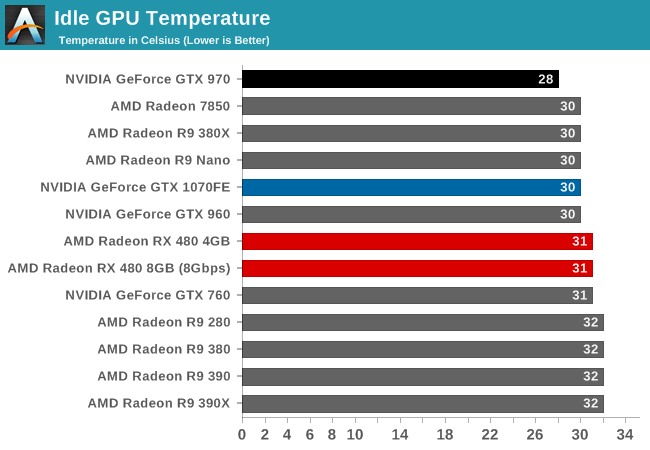
Moving on to idle GPU temperatures, there’s little to remark on. At 31C, the RX 480’s blower based design is consistent with the other cards in our lineup.
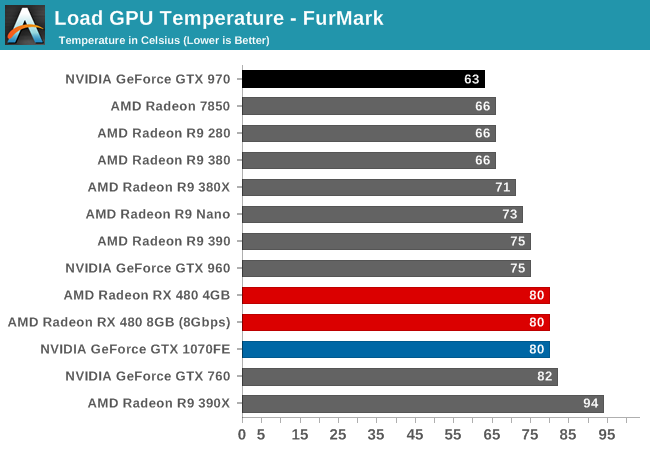
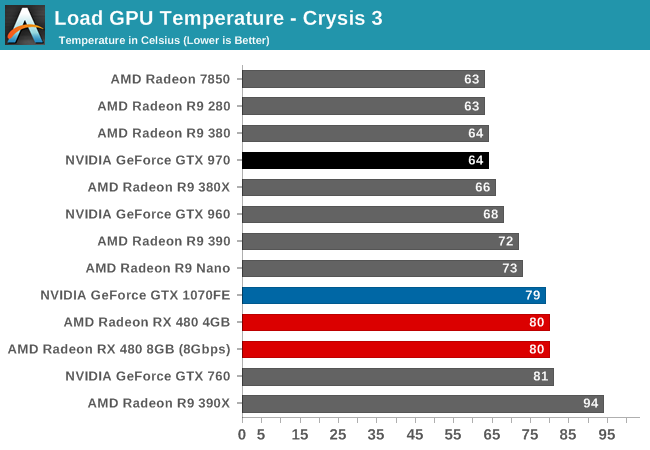
Meanwhile with load temperatures, we get to see the full impact of AMD’s new WattMan power management technology. The RX 480 has a temperature target of 80C, and it dutifully ramps up the fan to ensure it doesn’t exceed that temperature.

With idle noise levels RX 480 once again posts a good result. At 37.8dB, it’s in good company, only meaningfully trailing cards that idle silently due to their respective zero fan speed idle implementations.
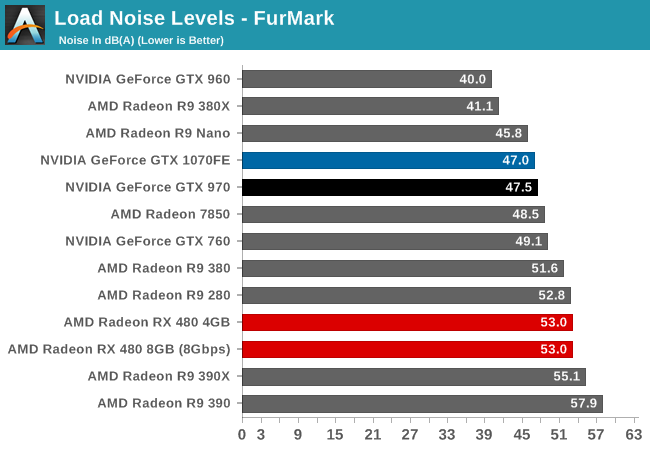
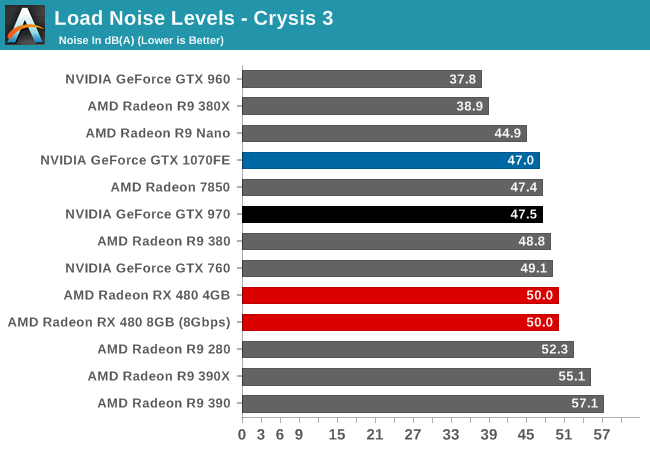
Finally, with load noise levels, RX 480 produces middling (but acceptable) results. Given that we have a mix of blowers and open air coolers here, the RX 480 performs similarly to other mainstream blower based cards. The $199 price tag means that AMD can’t implement any exotic cooling or noise reduction technologies, though strictly speaking it doesn’t need them.










449 Comments
View All Comments
Flunk - Thursday, June 30, 2016 - link
The Crossfire reviews I've read have said the GTX 1070 is faster on average than RX 480 Crossfire, maybe you should go read those reviews.Murloc - Tuesday, July 5, 2016 - link
comparing crossfire/sli to a single gpu is really useless. Multigpu means lots of heat, noise, power consumption, driver and game support issues, and performance that is most certainly not doubled on many games.Most people want ONE video card and they're going to get the one with the best bang for buck.
R0H1T - Wednesday, June 29, 2016 - link
For $200 I'll take this over the massive cash grab i.e. FE obviously!Wreckage - Wednesday, June 29, 2016 - link
Going down with the ship eh? It took AMD 2 years to compete with the 970. I guess we will have to wait until 2018 to see what they have to go against the 1070looncraz - Wednesday, June 29, 2016 - link
Two years to compete with the 970?The 970's only advantage over AMD's similarly priced GPUs was power consumption. That advantage is now gone - and AMD is charging much less for that level of performance.
The RX480 is a solid GPU for mainstream 1080p gamers - i.e. the majority of the market. In fact, right now, it's the best GPU to buy under $300 by any metric (other than the cooler).
Better performance, better power consumption, more memory, more affordable, more up-to-date, etc...
stereopticon - Wednesday, June 29, 2016 - link
are you kidding me?! better power consumption?! its about the same as the 970... it used something like 13 lets watts while running crysis 3... if the gtx1060 ends up being as good this card for under 300 while consuming less watts i have no idea what AMD is gonna do. I was hoping for this to have a little more power (more along 980) to go inside my secondary rig.. but we will see how the 1060 performance.i still believe this is a good card for the money.. but the hype was definitely far greater than what the actual outcome was...
adamaxis - Wednesday, June 29, 2016 - link
Nvidia measures power consumption by average draw. AMD measures by max.These cards are not even remotely equal.
dragonsqrrl - Wednesday, June 29, 2016 - link
"Nvidia measures power consumption by average draw. AMD measures by max."That's completely false.
CiccioB - Friday, July 1, 2016 - link
Didn't you know that when using AMD HW the watt meter switches to "maximum mode" while when applying the probes on nvidia HW it switched to "average mode"?Ah, ignorance, what a funny thing it is
dragonsqrrl - Friday, July 8, 2016 - link
@CiccioBNo I didn't, source? Are you suggesting that the presence of AMD or Nvidia hardware in a system has some influence over metering hardware use to measure power consumption? What about total system power consumption from the wall?
At least in relation to advertised TDP, which is what my original comment was referring to, I know that what adamaxis said about avg and max power consumption is false.